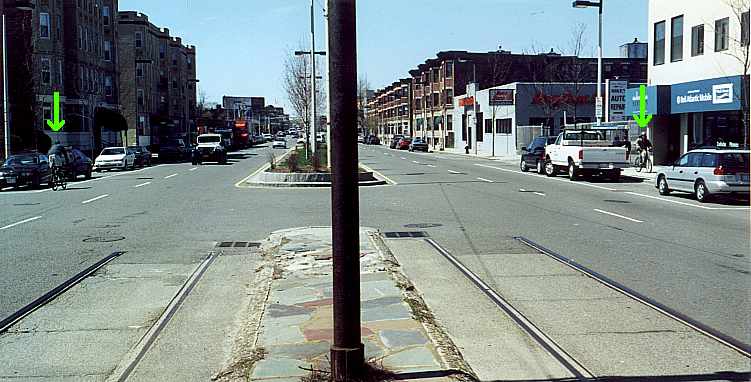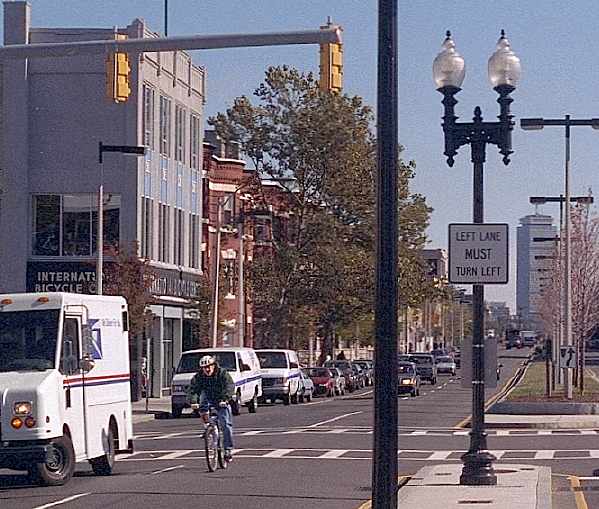
Top: Home Page
Up: Table of Contents
Previous:
Next:
Many people still like to have fireplaces in their homes, although any energy efficiency consultant will tell you that a fireplace is a very primitive and inefficient heating appliance. Its only significant advantage is that it uses a renewable energy source. But most of the heat it generates goes up the chimney, along with a lot of other warm air it sucks out of the house. A fireplace is also a fire hazard and generates a lot of air pollution. But many people still want to have fireplaces, because they like to sit in front of the fire the way they did at their grandparents' house. The 1999 reconstruction of Brighton Avenue in Allston is an example of the same kind of nostalgia that leads people to build fireplaces. The project created greenspace -- actually, something much more desirable than fireplaces in today's world -- but in a narrow no man's land of a median strip. Travel conditions -- which also ought to be a major concern in reconstructing an arterial such as Brighton Avenue -- are now significantly worse for bicyclists and motorists, and not much if at all better for pedestrians. A major opportunity for real improvement was lost, and will not occur again until the next reconstruction, in another 50 or 100 years. There was one improvement, which does nothing to increase the width of the right-and travel lane: left-turn lanes where the median narrows before some intersections. The reconstruction was made possible by the abandonment of the MBTA Green Line streetcar tracks that ran down the middle of Brighton Avenue. The foreground of the picture below shows a stretch of Brighton Avenue about 1000 feet west of the intersection with Commonwealth Avenue where the tracks were not taken up. Mike's Auto Repair is visible at the right side of the image, and you may search on that name in Google Maps to see how the same location looks now. In the background, you can see the new cross section. The traffic lanes have been significantly narrowed in order to build a wider, grassy median strip with high curbs. |

It used to be possible to ride a bicycle safely on Brighton Avenue while being overtaken by two lanes of motor traffic. Now that is no longer possible. Knowledgeable bicyclists ride in the middle of the right lane, to force motorists to merge to the inner lane. Less knowledgeable bicyclists like the two indicated by green arrows in the photo make unsafe and nonstandard maneuvers. Riding on the sidewalk is common here, because it is wide and the lanes in the street are narrow. Brighton Avenue carries a significant amount of bicycle traffic. It is near Boston University, and many students live in off-campus apartments. Why did the reconstruction of Brighton Avenue get botched? My understanding is that the community participation process went wrong. Neighborhood residents envisioned a Brighton Avenue more like Commonwealth Avenue in Back Bay -- a handsome divided boulevard with a parklike median. The residents even asked for, and got, nostalgic streetlights for part of the reconstruction, as shown in the photo below. Unfortunately, the comparison with Commonwealth Avenue doesn't make sense. The median of Commonwealth Avenue is about 100 feet wide. It has paths, park benches, and wide grassy areas. It is used by residents as parkland. The new median of Brighton Avenue is about ten feet wide. Can you imagine anyone intentionally walking along it to enjoy the fresh air? |

One of the businesses along Brighton Avenue is Boston's largest bicycle shop, International Bicycle Center, visible behind the double-parked Post Office truck in the photo above. I am not sure why International Bicycle's voice was not heard in the public process that preceded the reconstruction. Getting to or from International Bicycle on a bicycle is less attractive than it used to be. Notice also that the crosswalks are carried across the intersection rather than connecting with the medians. What would have made more sense here? First of all, the median ought to have been left at its original width. There still would have been room for light poles, even nostalgic ones, and for a pedestrian refuge. A low, paved median without the massive granite curbstones and deep excavations required for the plantings would have been far less expensive. The funding then could have gone for more sensible improvements. Pedestrians could have been better accommodated by neckdowns at the sides of the street rather than a wider median in the middle of the street. Depending on their width, neckdowns might increase delays caused by vehicles waiting to turn right, but on the other hand, the neckdowns would serve a useful purpose and would not affect the width of the through travel lanes. The first block of Brighton Avenue west of Commonwealth Avenue is very long. Mid- block neckdowns with a crosswalk here would be appropriate and could also allow for extensive plantings. Trees and plantings at the sides of the street are where pedestrians can enjoy them, rather than in a no-man's-land median. Even without neckdowns, the sidewalks are already wide enough for trees -- some are visible in the photo above, though much of the sidewalk in the reconstructed area is treeless. (This article is from the year 2000 or slightly later, updated December 19, 2019. For my more recent comments on Brighton Avenue, look here: http://streetsmarts.bostonbiker.org/2013/11/22/701/ Also, not all the track has been removed -- a short stretch remains at the intersection with Commonwealth Avenue, in the path of bicyclists turning left to continue on Commonwealth Avenue, and bicyclists have crashed there. ) |